Conservation Agriculture for Environmental Sustainability in A Semiarid Agroecological Zone under Climate Change Scenarios
Abstract
:1. Introduction
An Overview of Conservation Agriculture in Tanzania
2. Materials and Methods
2.1. Profile of the Study Site
2.2. Agricultural Systems in the Area
2.3. Methodology
2.3.1. Data Collection and Sampling Design
2.3.2. Data and Statistical Analyses
3. Results
3.1. Recent Adoption of Conservation Agriculture
3.2. Crop Yields
4. Discussion
4.1. Conservation Agriculture
4.2. Crop Yields
4.3. Irrigation
4.4. Fertilization
4.5. Environmental Sustainability
5. Conclusions
Author Contributions
Acknowledgments
Conflicts of Interest
References
- Jenrich, M. Potential of precision conservation agriculture as a means of increasing productivity and incomes for smallholder farmers. J. Soil Water Conserv. 2011, 66, 171A–174A. [Google Scholar] [CrossRef]
- Vanlauwe, B.; Wendt, J.; Giller, K.E.; Corbeels, M.; Gerard, B.; Nolte, C. A fourth principle is required to define conservation agriculture in sub-Saharan Africa: The appropriate use of fertilizer to enhance crop productivity. Field Crop Res. 2014, 155, 10–13. [Google Scholar] [CrossRef]
- Baker, J.M.; Ochsner, T.E.; Venterea, R.T.; Griffis, T.J. Tillage and soil carbon sequestration—What do we really know? Agric. Ecosyst. Environ. 2007, 118, 1–5. [Google Scholar] [CrossRef]
- Lal, R. World Soils and the Carbon Cycle in Relation to Climate Change and Food Security; Carbon Management and Sequestration Center, The Ohio State University: Columbus, OH, USA, 2012. [Google Scholar]
- Penfold, C. Grape and Wine Research and Development Corporation: “Herbicide Reduction Strategies for Winegrape Production”; University of Adelaide: Adelaide, Australia, 2003. [Google Scholar]
- Thierfelder, C.; Cheesman, S.; Rusinamhodzi, L. A comparative analysis of conservation agriculture systems: Benefits and challenges of rotations and intercropping in Zimbabwe. Field Crops Res. 2012, 137, 237–250. [Google Scholar] [CrossRef]
- Ngwira, A.; Johnsen, F.H.; Aune, J.B.; Mekuria, M.; Thierfelder, C. Adoption and extent of conservation agriculture practices among smallholder farmers in Malawi. J. Soil Water Conserv. 2014, 69, 107–119. [Google Scholar] [CrossRef] [Green Version]
- Mattee, A.Z. The adoption of agricultural innovations by small farmers in Tanzania: An analysis of the research needs. Afr. Study Monogr. 1994, 15, 167–176. [Google Scholar]
- Rogers, E.M. Diffusion of Innovations; Free Press: New York, NY, USA, 1995. [Google Scholar]
- Mwaseba, D.L.; Kaarhus, R.; Johnsen, F.H.; Mvena, Z.S.K.; Matte, A.Z. Beyond adoption/rejection of agricultural innovations. Outlook Agric. 2006, 35, 263–272. [Google Scholar] [CrossRef]
- Delgado, J.; Groffman, P.; Nearing, M.; Goddard, T.; Reicosky, D.; Lal, R.; Kitchen, N.R.; Rice, C.W.; Salon, P.; Towery, D. Conservation practices to mitigate and adapt to climate change. J. Soil Water Conserv. 2011, 66, 118A–129A. [Google Scholar] [CrossRef]
- Bennett, R.G.; Ryan, M.H.; Colmer, T.D.; Real, D. Prioritization of novel pasture species for 490 use in water-limited agriculture: A case study of Cullen in the Western Australian wheatbelt. Genet. Resour. Crop. Evol. 2011, 58, 83–100. [Google Scholar] [CrossRef]
- Malviya, S.; Priyanka, N.; Irfan-Ullah, M.; Davande, S.; Joshi, P.K. Distribution potential of 563 simarouba glauca under climate change—Strategizing rural livelihood adaptation. Int. J. Geoinform. 2013, 9, 31–37. [Google Scholar]
- Zhu, J.; Hu, H.; Tao, S.; Chi, X.; Li, P.; Jiang, L.; Ji, C.; Zhu, J.; Tang, Z.; Pan, Y.; et al. Carbon stocks and changes of dead organic matter in China’s forests. Nat. Commun. 2017, 8. [Google Scholar] [CrossRef] [PubMed]
- Paavola, J. Livelihoods, vulnerability and adaptation to climate change in Morogoro, Tanzania. Environ. Sci. Policy 2008, 11, 642–654. [Google Scholar] [CrossRef]
- Challinor, A.J.; Watson, J.; Lobell, D.B.; Howden, S.M.; Smith, D.R.; Chhetri, N. A meta-analysis of crop yield under climate change and adaptation. Nat. Clim. Chang. 2014, 4, 287–291. [Google Scholar] [CrossRef]
- FAO. Investing in Sustainable Agricultural Intensification: The Role of Conservation Agriculture. A Framework for Action; FAO: Rome, Italy, 2008. [Google Scholar]
- Field, C.B.; Barros, V.R.; Estrada, R.C.; Genova, B.; Girma, E.S.; Kissel, A.N.; Levy, S.; MacCracken, P.R.; Mastrandrea, L.L. (Eds.) Intergovernmental Panel on Climate Change (2014a) Climate Change Impacts. Adaptation, and Vulnerability. Part A: Global and Sectoral Aspects. In Contribution of Working Group II to the Fifth Assessment Report of the Intergovernmental Panel on Climate Change; Cambridge University Press: Cambridge, UK; New York, NY, USA, 2014. [Google Scholar]
- Nyong, A.; Francis, A.; Osman-Elasha, B. The value of indigenous knowledge in climate change mitigation and adaptation strategies in the African Sahel. Mitig. Adapt. Strat. Glob. Chang. 2007, 12, 787–797. [Google Scholar] [CrossRef]
- Neufeldt, H.; Jahn, M.; Campbell, B.M.; Beddington, J.R.; DeClerck, F.; de Pinto, A.; Gulledge, J.; Hellin, J.; Herrero, M.; Jarvis, A.; et al. Beyond climate smart agriculture: Toward safe operating spaces for global food systems. Agric. Food Secur. 2013, 2, 12. [Google Scholar] [CrossRef] [Green Version]
- Duru, M. How to implement biodiversity-based agriculture to enhance ecosystem services. Agron. Sustain. Dev. 2015, 35, 1259–1281. [Google Scholar] [CrossRef]
- Plaza-Bonilla, D.; Luis-Arrúe, J.; Cantero-Martínez, C.; Fanlo, R.; Álvaro-Fuentes, A. Carbon management in dryland agricultural systems. Agron. Sustain. Dev. 2015, 35, 1319–1334. [Google Scholar] [CrossRef]
- Ye, L.; Xiong, W.; Li, Z.; Yang, P.; Wu, W.; Yang, G.; Fu, Y.; Zou, J.; Chen, Z.; Van Ranst, E.; et al. Climate change impact on China food security in 2050. Agron. Sustain. Dev. 2013, 33, 363–374. [Google Scholar] [CrossRef] [Green Version]
- Rowhani, P.; Lobell, D.B.; Linderman, M.; Ramankutty, N. Climate variability and crop production in Tanzania. Agric. For. Meteorol. 2011, 15, 449–460. [Google Scholar] [CrossRef]
- Ahmed, S.; Deffenbaugh, N.; Hertel, T.; Lobell, D.; Ramankutty, N.; Rios, A.; Rowhani, P. Climate volatility and poverty vulnerability in Tanzania. Glob. Environ. Chang. 2011, 21, 46–55. [Google Scholar] [CrossRef]
- Kimaro, A.; Mpanda, M.; Rioux, J.; Aynekulu, E.; Shaba, S.; Thiong’o, M.; Mutuo, P.; Abwanda, S. Is conservation agriculture ‘climate-smart’ for maize farmers in the highlands of Tanzania? Nutr. Cycl. Agroecosyst. 2015, 3, 217–228. [Google Scholar] [CrossRef]
- Vanlauwe, B. Integrated soil fertility management research at TSBF: The framework, the principles, and their application. In Managing Nutrient Cycles to Sustain Soil Fertility in Sub-Saharan Africa; Bationo, A., Ed.; Academy Science Publishers: Nairobi, Kenya, 2004. [Google Scholar]
- Hartemink, A.E.; Veldkamp, T.; Bai, Z. Land cover change and soil fertility decline in tropical regions. Turk. J. Agric. For. 2008, 32, 195–213. [Google Scholar]
- Haoa, Q.; Jianga, C.; Chaia, X.; Huanga, Z.; Fana, Z.; Xiea, D.; He, X.H. Drainage, no-tillage and crop rotation decreases annual cumulative emissions of methane and nitrous oxide from a rice field in Southwest China. Agric. Ecosyst. Environ. 2016, 233, 270–281. [Google Scholar] [CrossRef]
- Lienhard, P.; Tivet, F.; Chabanne, A.; Dequiedt, S.; Lelièvre, M.; Sayphoummie, S.; Leudphanane, B.; Prévost-Bouré, N.C.; Séguy, L.; Maron, P.-A.; et al. No-till and cover crops shift soil microbial abundance and diversity in Laos tropical grasslands. Agron. Sustain. Dev. 2013, 33, 375–384. [Google Scholar] [CrossRef] [Green Version]
- Duru, M.; Therond, O.; Fares, M. Designing agroecological transitions. Agron. Sustain. Dev. 2015, 35, 1237–1257. [Google Scholar] [CrossRef]
- Harvey, C.A.; Chacón, M.; Donatti, C.I.; Garen, E.; Hannah, L.; Andrade, A.; Bede, L.; Brown, D.; Calle, A.; Chará, J.; et al. Climate-smart landscapes: Opportunities and challenges for integrating adaptation and mitigation in tropical agriculture. Conserv. Lett. 2014, 7, 77–90. [Google Scholar] [CrossRef]
- FAO. Climate-Smart Agriculture Sourcebook; FAO: Rome, Italy, 2013. [Google Scholar]
- Lal, R. Sequestering carbon and increasing productivity by conservation agriculture. J. Soil Water Conserv. 2015, 70, 55A–62A. [Google Scholar] [CrossRef]
- Mohammadshirazi, F.; Brown, V.K.; Heitman, J.L.; McLaughlin, R.A. Effects of tillage and compost amendment on infiltration in compacted soils. J. Soil Water Conserv. 2016, 71, 443–449. [Google Scholar] [CrossRef]
- Hartemink, A.E. Soils Fertility Decline in Some Major Soil Groupings under Permanent Cropping in Tanga Region, Tanzania. Geoderma 1997, 75, 215–229. [Google Scholar] [CrossRef]
- Glaser, B.; Lehmann, J.; Führböter, M.; Solomon, D.; Zech, W. Carbon and nitrogen mineralization in cultivated and natural savanna soils of Northern Tanzania. Biol. Fertil. Soils 2001, 33, 301–309. [Google Scholar] [CrossRef]
- Sen, A.K. Development as Freedom; Knopf, A., Ed.; Oxford University Press: New York, NY, USA, 1999. [Google Scholar]
- Sosovele, H.; Schechambo, F.; Kisanga, D. Rethinking Natural Resource Degradation in Semi-Arid Sub-Saharan Africa: The Case of Semi-Arid Tanzania; Overseas Development Institute (ODI): London, UK, 1999. [Google Scholar]
- Kahimba, F.C.; Mutabazi, K.D.; Tumbo, S.D.; Masuki, K.F.; Mbungu, W.B. Adoption and Scaling-Up of Conservation Agriculture in Tanzania: Case of Arusha and Dodoma Regions. Nat. Resour. 2014, 5, 161–176. [Google Scholar] [CrossRef]
- FAO. Conservation Agriculture for SARD and Food Security in Southern and Eastern Africa. Terminal Report, Kenya and Tanzania; FAO: Rome, Italy, 2006. [Google Scholar]
- FAO. Conservation Agriculture and Sustainable crop Intensification. In Karatu District, Tanzania. Integrated Crop Management; FAO: Rome, Italy, 2012; Volume 15-2012. [Google Scholar]
- Heckman, J.J. Sample selection bias as a specification error. Econometrica 1979, 47, 153–161. [Google Scholar] [CrossRef]
- Mkonda, M.Y.; He, X.H. Conservation Agriculture in Tanzania. Sustain. Agric. Rev. 2017, 22, 309–324. [Google Scholar]
- Mkonda, M.Y.; He, X.H. Yields of the Major Food Crops: Implications to Food Security and Policy in Tanzania’s Semi-arid Agro-ecological Zone. Sustainability 2017, 9, 1490. [Google Scholar] [CrossRef]
- FAO. FAO/Unesco Soil Map of the World, Revised Legend, with Corrections and Updates. (World Soil Resources Report 60); FAO: Rome, Italy, 1988; reprinted with updates as Technical Paper 20; ISRIC: Wageningen, The Netherlands, 1997. [Google Scholar]
- Bationo, A.; Kihara, J.; Vanlauwe, B.; Waswa, B.; Kimetu, J. Soil organic carbon dynamics, functions and management in West African agro-ecosystems. Agric. Syst. 2006, 94, 13–25. [Google Scholar] [CrossRef]
- Solomon, D.; Lehmann, J.; Zech, W. Land use effects on soil organic matter properties of chromic Luvisols in the semiarid tropics: Carbon, nitrogen, lignin and carbohydrates. Agric. Ecosyst Environ. 2000, 78, 203–213. [Google Scholar] [CrossRef]
- Cramb, R.A.; Purcell, T.; Ho, T.C.S. Participatory assessment of rural livelihoods in the Central Highlands of Vietnam. Agric. Syst. 2004, 81, 255–272. [Google Scholar] [CrossRef]
- Brown, M.E. Assessing natural resource management challenges in Senegal using data from participatory rural appraisals and remote sensing. World Dev. 2006, 34, 751–767. [Google Scholar] [CrossRef]
- Humphrey, W.K.; Kimberly, E.M. Participatory resource mapping for adaptive collaborative management at Mt. Kasigau. Landsc. Urban Plan. 2007, 82, 145–158. [Google Scholar]
- Dixon, J.; Gulliver, A.; Gibbon, D. Farming Systems and Poverty; FAO and World Bank: Rome, Italy, 2001. [Google Scholar]
- URT. Tanzania National Sample Census of Agriculture 2007/2008 Small Holder Agriculture: Regional Report—Singida Region (Volume Vm); Ministry of Agriculture, Food Security and Cooperatives, Ministry of Livestock Development and Fisheries, Ministry of Water and Irrigation, Ministry of Agriculture, Livestock and Environment: Zanzibar, Tanzania, 2012.
- United Republic of Tanzania (URT). National Agriculture Policy; Government Publishing Press: Dar es Salaam, Tanzania, 2013.
- Mkonda, M.Y.; He, X.H. Are Rainfall and Temperature Really Changing? Farmer’s Perceptions, Meteorological Data, and Policy Implications in the Tanzanian Semi-Arid Zone. Sustainability 2017, 9, 1412. [Google Scholar] [CrossRef]
- Mkonda, M.Y.; He, X.H.; Sandell, F.E. Comparing smallholder farmers’ perception of climate change with meteorological data: Experiences from seven agro-ecological zones of Tanzania. Weather Clim. Soc. J. 2018. [Google Scholar] [CrossRef]
- Mkonda, M.Y.; He, X.H. Climate Variability and Crop Yields Synergies under Rain-fed Agriculture in Tanzania’s Semi-arid Agro-ecological Zone. Ecosyst. Health Sustain. 2018, 4, 59–72. [Google Scholar] [CrossRef]
- Mkonda, M.Y.; He, X.H. Vulnerability Assessment of the Livelihoods in Tanzania’s Semi-Arid Agro-Ecological Zone under Climate Change Scenarios. Climate 2018, 6, 27. [Google Scholar] [CrossRef]
- Mkonda, M.Y.; He, X.H. Accumulation of SOC under organic and no-fertilizations and its influence to crop yields in Tanzania’s semi-arid zone. Ecosyst. Health Sustain. 2018, 4, 34–47. [Google Scholar]
- Servadio, P.; Bergonzoli, S.; Beni, C. Soil Tillage Systems and Wheat Yield under Climate Change Scenarios. Agronomy 2016, 6, 43. [Google Scholar] [CrossRef]
- Servadio, P.; Bergonzoli, S.; Toderi, M. Soil mapping to assess workability in central Italy as climate change adaptation techniques. Glob. NEST J. 2014, 16, 229–239. [Google Scholar]
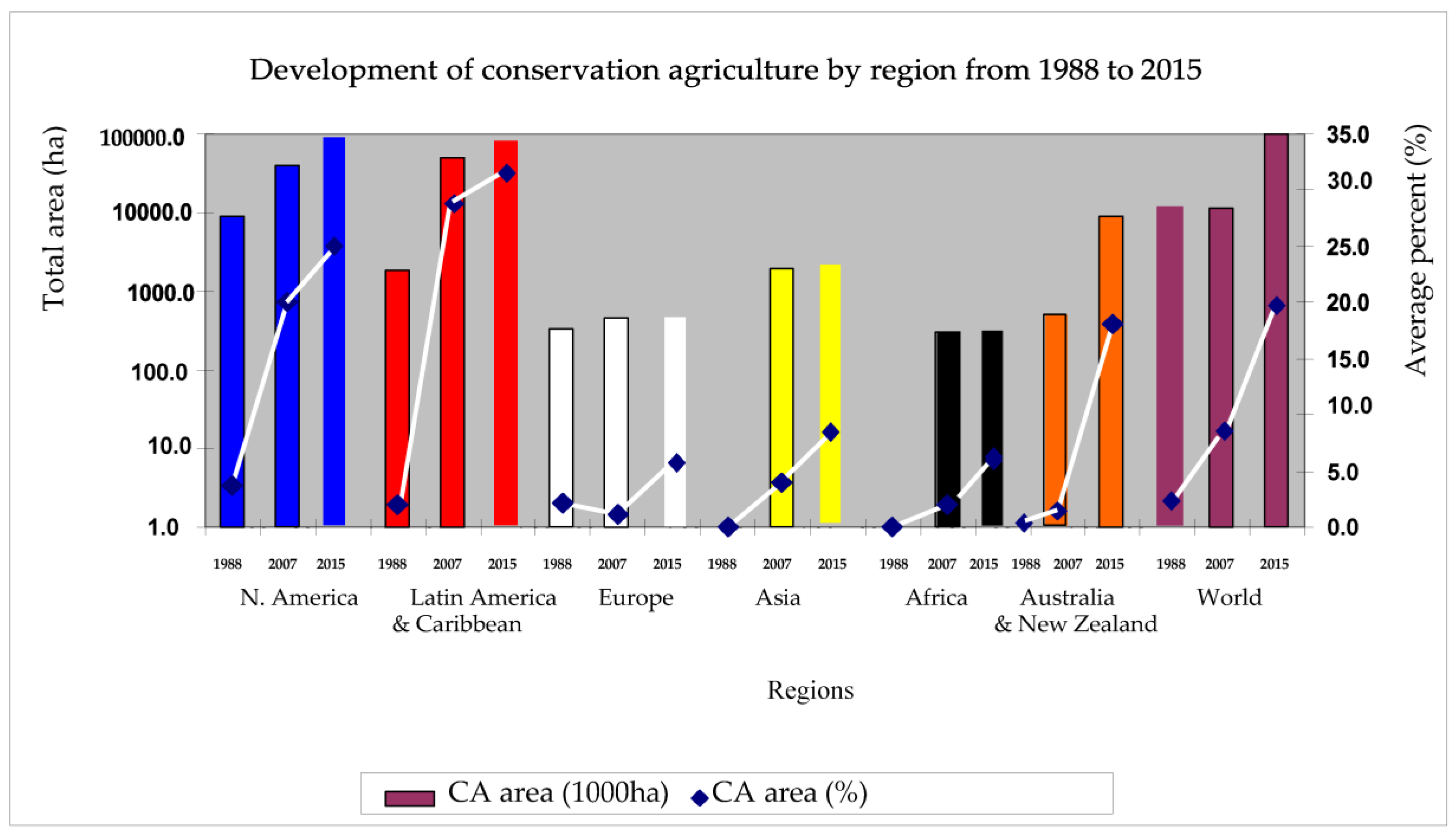
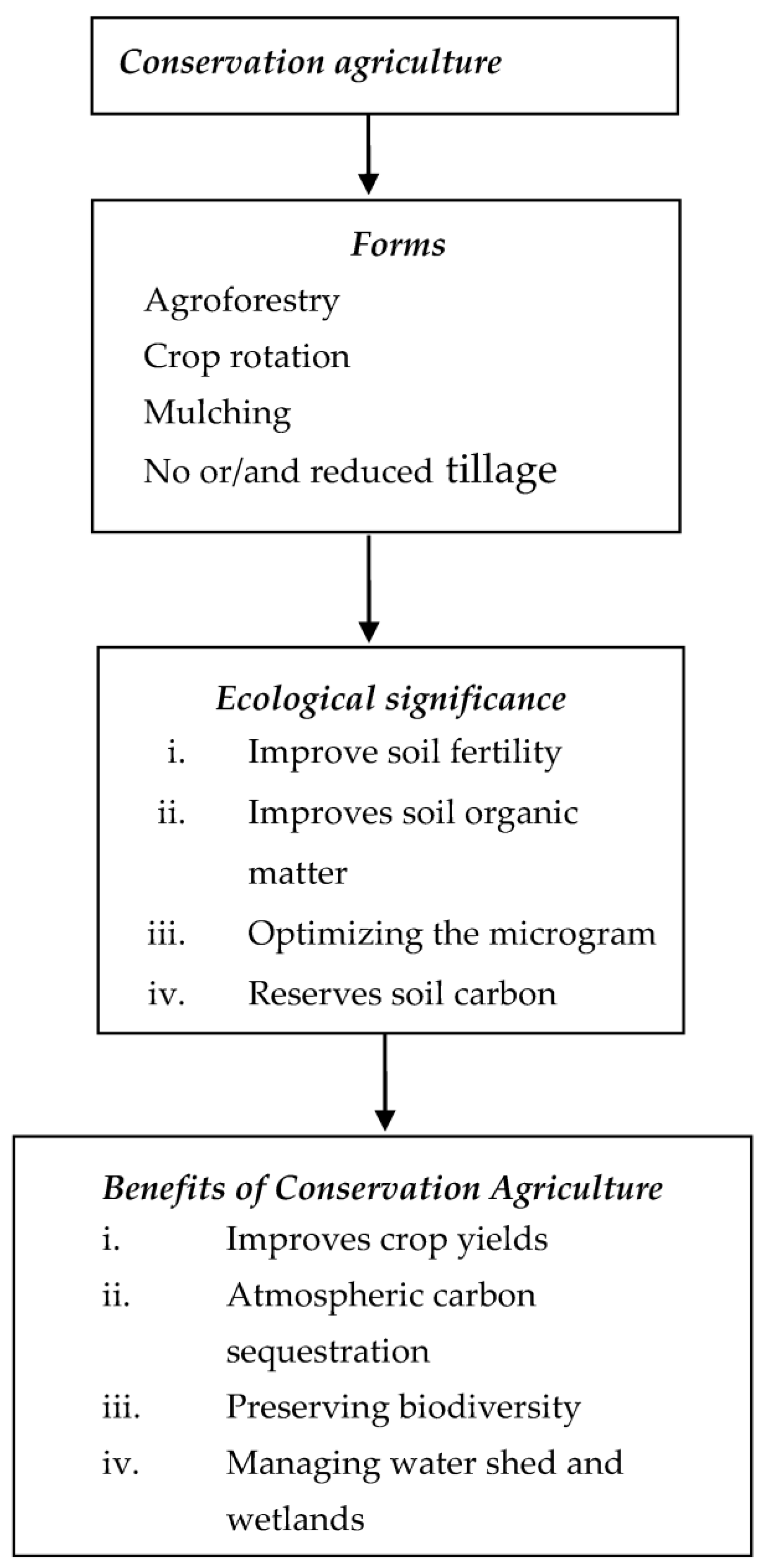
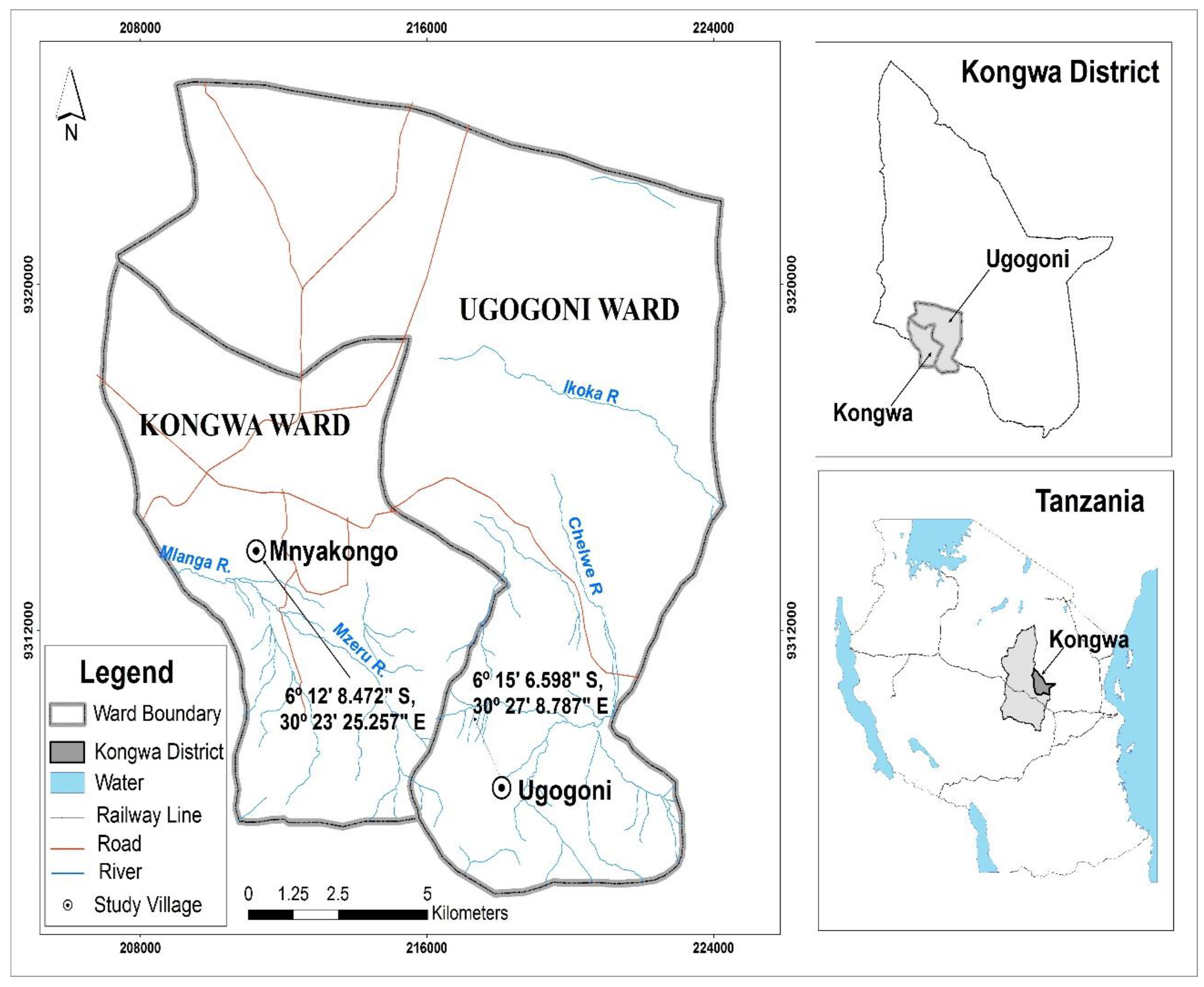
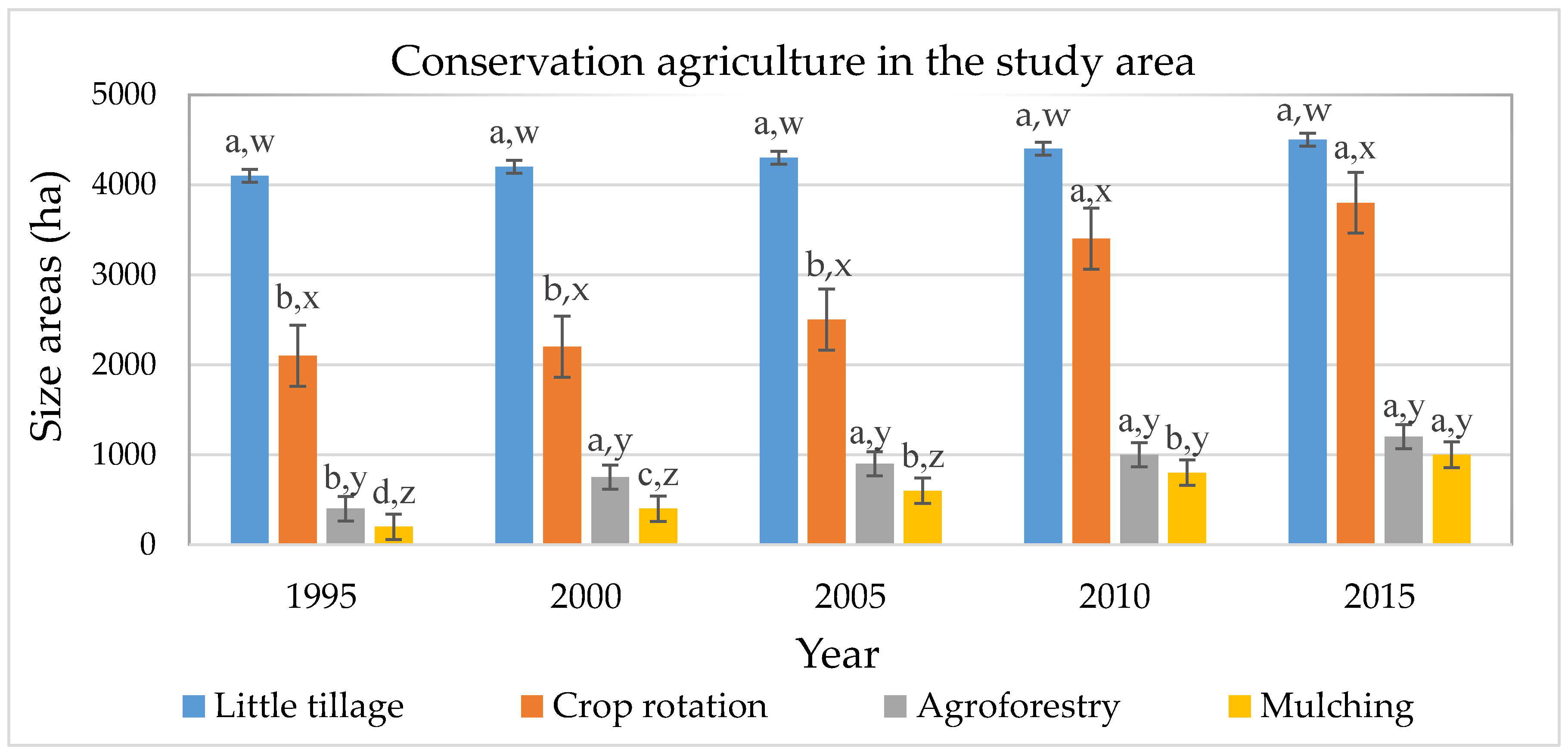
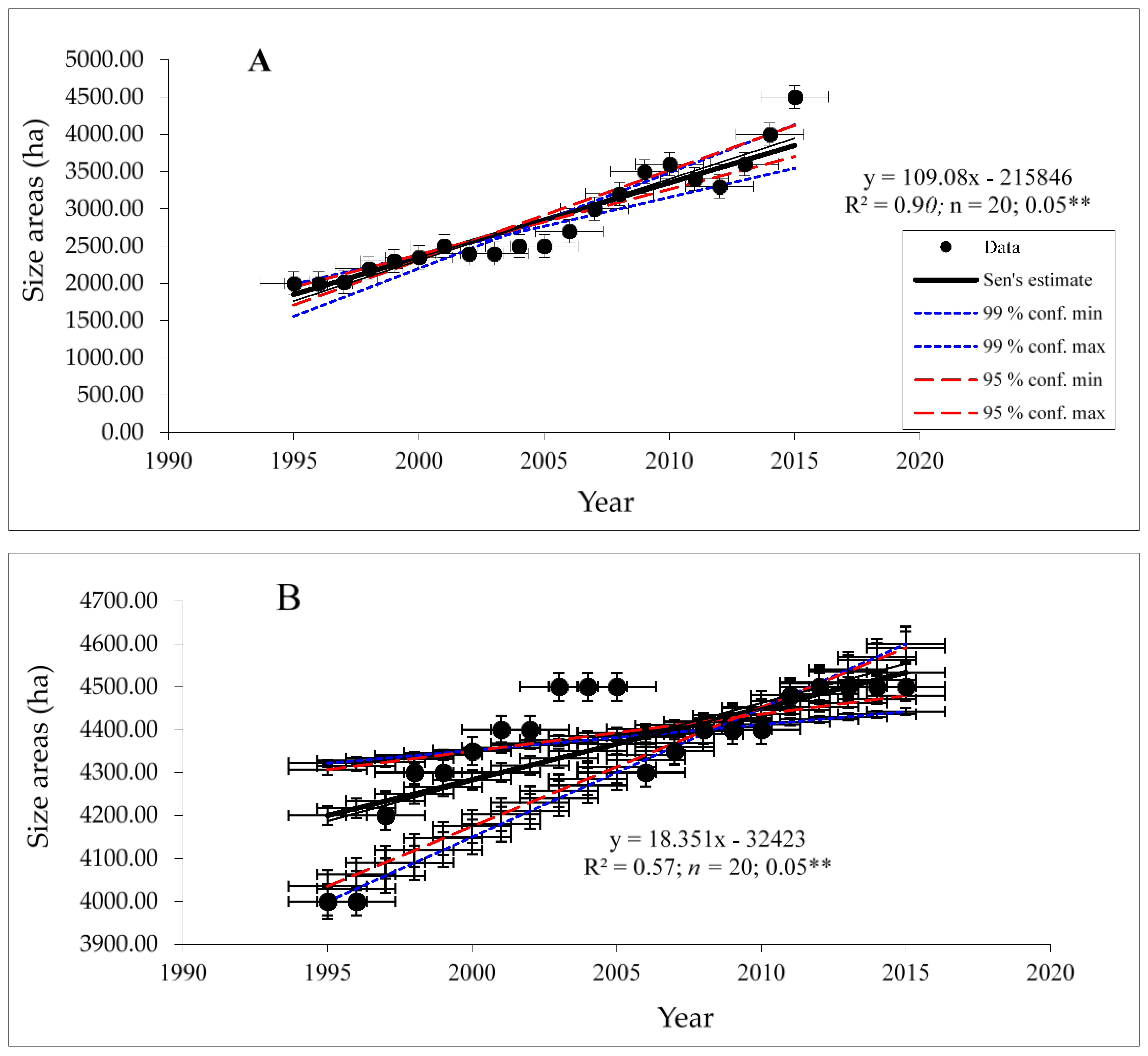


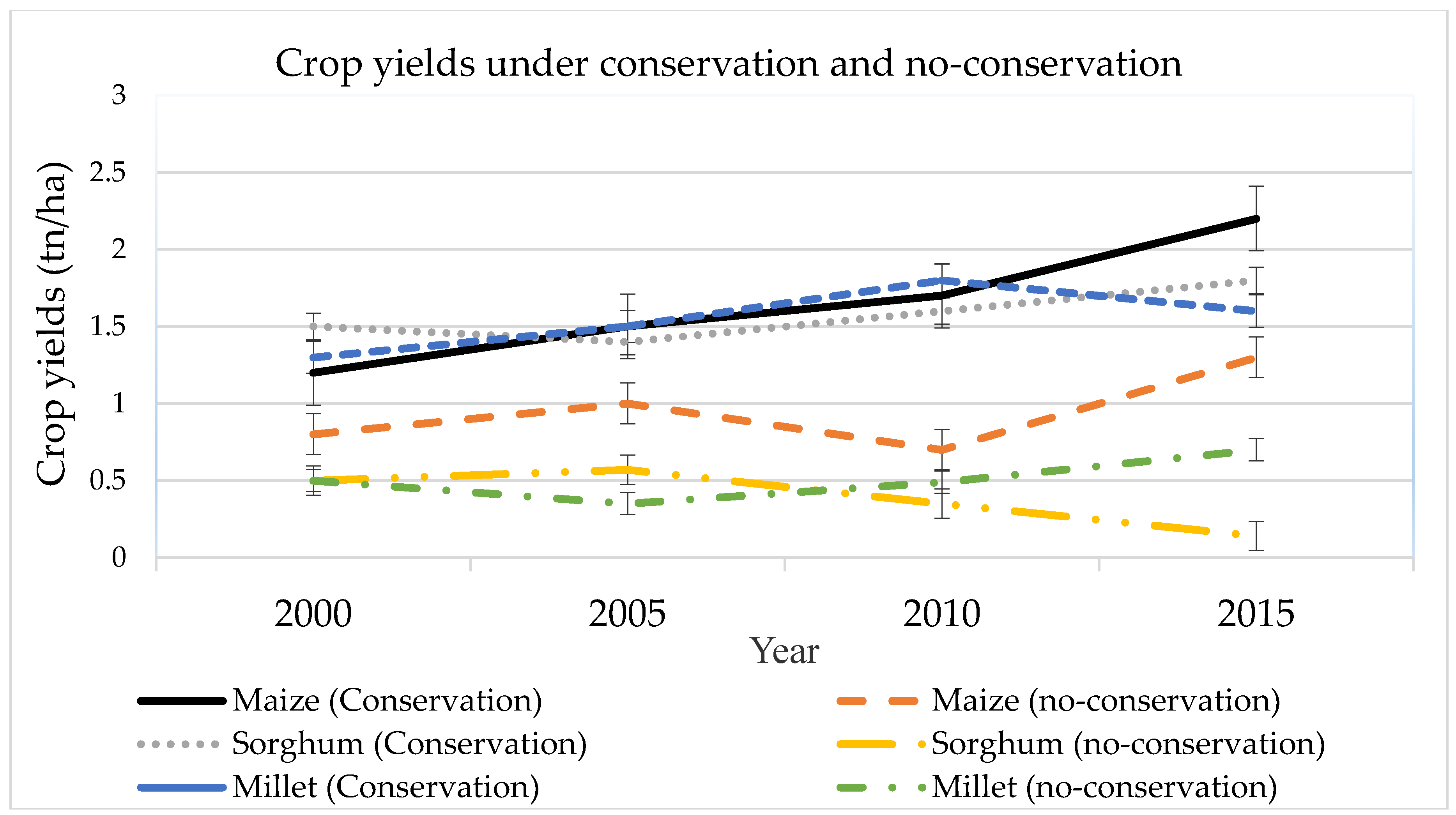
| Mnyakongo | Ugogoni | |
|---|---|---|
| Questionnaires (n = 400) | Total HH (2050) | Total HH (2080) |
| Number of households interviewed | 200 | 200 |
| Crop farmers (%) | 70 | 80 |
| Livestock farmers (%) | 10 | 10 |
| Both crop and livestock farmers (%) | 20 | 10 |
| Focus group discussion (n = 30) | ||
| Crop farmers | 12 | 10 |
| Livestock farmers | 0 | 2 |
| Both crop and livestock farmers | 3 | 3 |
| Interview (n = 20) | ||
| Crop farmers | 8 | 9 |
| Livestock farmers | 0 | 0 |
| Both crop and livestock farmers | 2 | 1 |
| Village | Total Cultivated Land (ha) | Average-Landholding Size (ha) | Average Land under CA (ha) | Adoption Rate (%) | Estimated Land under CA (ha) |
|---|---|---|---|---|---|
| Mnyakongo | 8600 | 3.5 | 0.34 | 8.7 | 90 |
| Ugogoni | 9200 | 4.1 | 0.38 | 11.4 | 105 |
| Conservation Methods | Very Effective | Moderate Effective | Not Sure | Not Effective | ||||
|---|---|---|---|---|---|---|---|---|
| Mn | Ug | Mn | Ug | Mn | Ug | Mn | Ug | |
| Agroforestry | 18 | 19 | 76 | 77 | 0 | 0 | 6 | 4 |
| Crop rotation | 71 | 73 | 22 | 25 | 7 | 2 | 0 | 0 |
| Little tillage | 15 | 16 | 67 | 71 | 13 | 10 | 5 | 3 |
| Mulching | 27 | 29 | 62 | 64 | 9 | 5 | 3 | 2 |
| Village | Optional Yields | Soil Moisture | Soil Fertility | Erosion Control | Reduced Labor | Others | Total |
|---|---|---|---|---|---|---|---|
| Mnyakongo | 21 | 7 | 8 | 8 | 5 | 2 | 49 |
| Ugogoni | 19 | 8 | 8 | 7 | 5 | 2 | 51 |
| 40 | 15 | 16 | 15 | 10 | 4 | 100 |
© 2018 by the authors. Licensee MDPI, Basel, Switzerland. This article is an open access article distributed under the terms and conditions of the Creative Commons Attribution (CC BY) license (http://creativecommons.org/licenses/by/4.0/).
Share and Cite
Hong, Z.; Mkonda, M.Y.; He, X. Conservation Agriculture for Environmental Sustainability in A Semiarid Agroecological Zone under Climate Change Scenarios. Sustainability 2018, 10, 1430. https://doi.org/10.3390/su10051430
Hong Z, Mkonda MY, He X. Conservation Agriculture for Environmental Sustainability in A Semiarid Agroecological Zone under Climate Change Scenarios. Sustainability. 2018; 10(5):1430. https://doi.org/10.3390/su10051430
Chicago/Turabian StyleHong, Zhang, Msafiri Y. Mkonda, and Xinhua He. 2018. "Conservation Agriculture for Environmental Sustainability in A Semiarid Agroecological Zone under Climate Change Scenarios" Sustainability 10, no. 5: 1430. https://doi.org/10.3390/su10051430
APA StyleHong, Z., Mkonda, M. Y., & He, X. (2018). Conservation Agriculture for Environmental Sustainability in A Semiarid Agroecological Zone under Climate Change Scenarios. Sustainability, 10(5), 1430. https://doi.org/10.3390/su10051430







